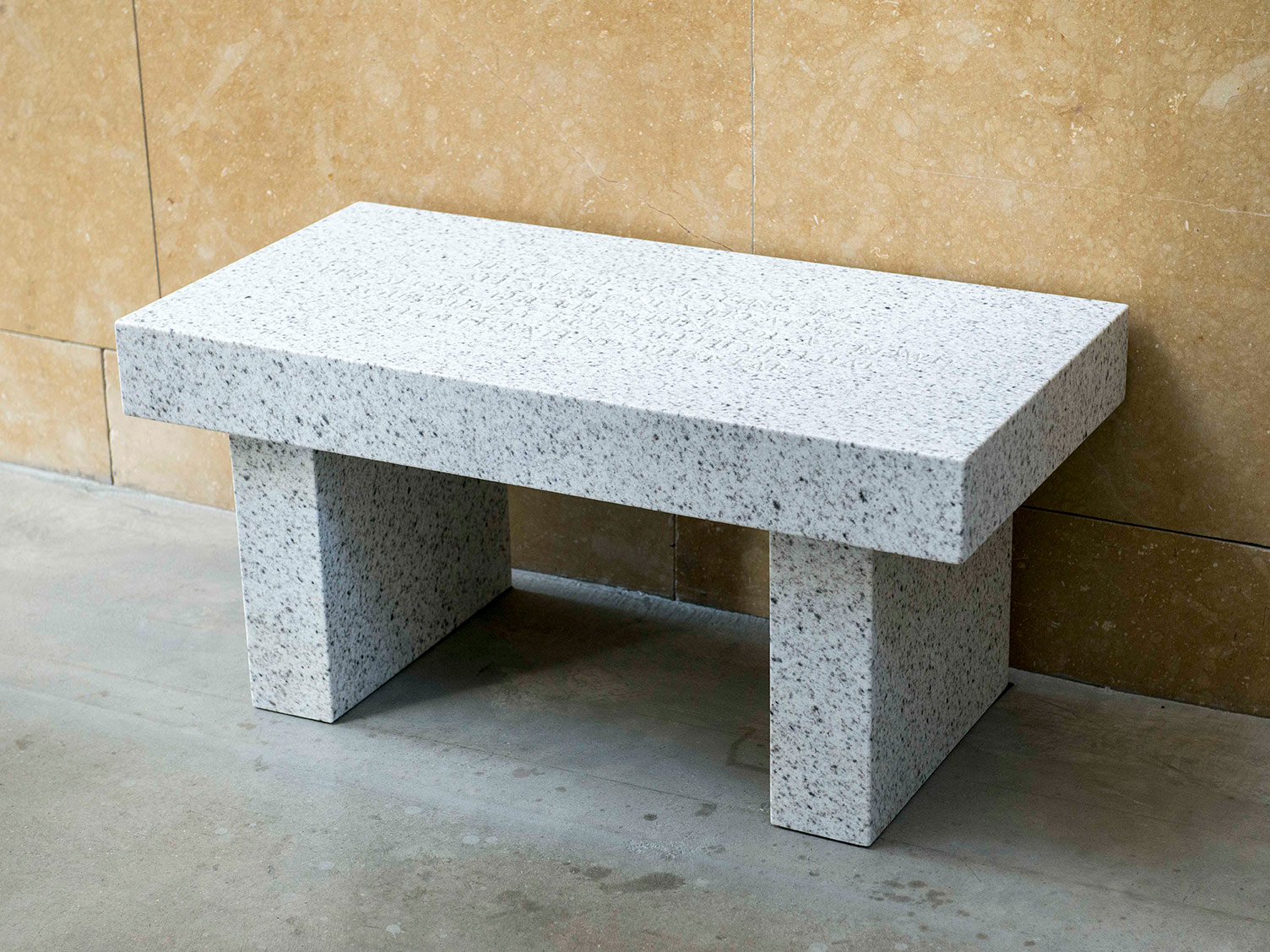
Living: It can be startling to see someone’s breath
“I didn’t want people to have to stand to read my texts on electronic signs. I wanted people to be comfortable, and to take time to look. So I thought to provide benches, and it came to me that I could put writing on the seating, and the benches should be stone.” —Jenny Holzer
For more than forty years, Jenny Holzer (b. 1950, Ohio) has presented her astringent ideas, arguments, and sorrows in public places and international exhibitions. Her medium, whether formulated as a T-shirt, a plaque, or an LED sign, is writing, and the public dimension is integral to the delivery of her work. Starting in the 1970s with the New York City posters, and continuing through her recent light projections on landscape and architecture, her practice has rivaled ignorance and violence with humor, kindness, and courage.
In the mid-1980s the artist began making stone benches, similar to those one might encounter in city parks or cemeteries. Of her work in stone, Holzer has said, “I appreciate and depend on the ephemeral and disembodied—and on solid rocks. … When words are carved in stone, they can be touched, they can be read with the hand, they might be perceived differently than when on the page. Marble and granite lock time while electronic signs and projections signal differently. Rows of benches might have people imagine waiting rooms, courtrooms, hospitals, and churches, for better and worse.”
Holzer invites everyone to sit on the benches, creating a communal and commemorative experience that offers a place for contemplation or group discussion. Unlike most art in a museum space, the works are functional and meant to be used. Holzer works with many kinds of stone and carefully selects materials that suit the engraved texts.
The benches here derive their inscriptions from two different bodies of text:
Survival, which Holzer wrote from 1983–85, is a cautionary series where each single sentence instructs, informs, or questions the ways an individual responds to his or her political, social, physical, psychological, and personal environments. The sentences are short and pointed so as to be easily available to passersby. PROTECT ME FROM WHAT I WANT is a key Survival text.
In the Living series, from 1980–82, the messages have a less urgent tone. Here, Holzer presents a set of quiet observations, directions, and warnings. The Living texts are written in a matter-of-fact, journalistic style suited to descriptions of everyday life. These are commentaries on how the embodied individual negotiates landscapes, persons, rules, expectations, desires, fears, other bodies, and the self.
Preguntas
Look closely at this artwork. How would you describe it? What features call your attention? If you were to explain the work to a friend, how would you do that? What would you emphasize? Have you seen a similar work of art before? Where?
What material is it made from? What are the characteristics of the material? What physical or emotional qualities does it suggest to you? Where can you find things made out of the same material? What does it remind you of? Why do you think the artist is interested this particular material?
In addition to inviting the viewer to look at and contemplate the work, Holzer’s pieces are functional and meant to be used. Sit on one of the benches. How do you feel about them? What types of sensations do you get from sitting on top of an art piece? What senses are stimulated while interacting with this piece? Have you interacted with an artwork in this way before? How is this art piece similar to or different from other works in the museum? Would your perception of the work change depending on the way it is exhibited? How? And what if you saw it on the street instead of in a museum?
Read the text on the bench. Holzer has said an aim with the stone was “to have the look of a voice of authority, of the establishment.” Do you think she accomplished this? How? For Holzer, when words are carved in stone, “they can be touched, they can be read with the hand, they might be perceived differently than when on the page.”[1] Do you agree with her statement?
Compare the pieces Living: It can be startling to see someone’s breath…, 1989, and Survival: Let your hand wander…, 1989. In what way they are similar? What are the differences between them? Do you perceive the messages carved in the benches differently? Why?
